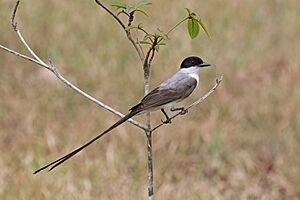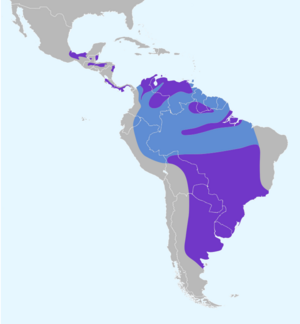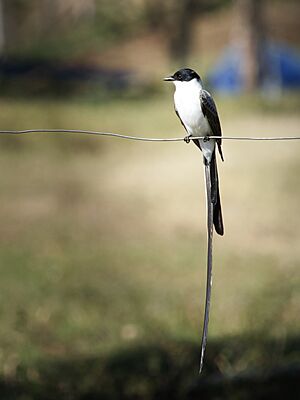Fork-tailed flycatcher facts for kids
Quick facts for kids Fork-tailed flycatcher |
|
|---|---|
 |
|
| Male T. s. monachus in Belize | |
 |
|
| Female T. s. monachus in Panama | |
| Conservation status | |
| Scientific classification | |
| Genus: |
Tyrannus
|
| Species: |
savana
|
 |
|
The fork-tailed flycatcher (Tyrannus savana) is a cool bird known for its super long, forked tail! It's part of the tyrant flycatcher family, which are often called kingbirds. You can spot these birds in open areas like grasslands or lightly forested places, all the way from southern Mexico down to Argentina.
These birds often sit on high branches, waiting for flying insects to pass by. When they see one, they quickly fly out, catch their prey, and then return to their perch. Some fork-tailed flycatchers in northern areas stay in one place all year. However, those living further south are migratory birds. They are known to travel far, sometimes even reaching places like New Brunswick, Canada.
Contents
What is a Fork-Tailed Flycatcher?
Naming the Fork-Tailed Flycatcher
The fork-tailed flycatcher got its scientific name, Tyrannus savana, in 1802 from a scientist named François Marie Daudin. The name "savana" comes from the word "savannah," which is a type of grassland where these birds live.
There are four different types, or subspecies, of the fork-tailed flycatcher:
- Tyrannus savana monachus: Found from southern Mexico to Colombia, the Guianas, and northern Brazil.
- Tyrannus savana sanctaemartae: Lives in northern Colombia and northwest Venezuela.
- Tyrannus savana circumdatus: Found in east-central Brazil.
- Tyrannus savana savana: Lives in central and southern South America, including the Falkland Islands.
Appearance of the Fork-Tailed Flycatcher
How to Identify a Fork-Tailed Flycatcher
The fork-tailed flycatcher has a white belly and a gray back. It also has a black cap on its head. Male birds sometimes have a yellow stripe on their crown, which is like a small crown on their head.
One of the most special things about this bird is its tail. Males have an extremely long, forked tail. It's even longer than the tail of a similar bird called the scissor-tailed flycatcher. Females have a shorter tail than males, and young birds have even shorter tails.
Male fork-tailed flycatchers are about 37 to 41 centimeters (14.5 to 16 inches) long. Females are a bit smaller, about 28 to 30 centimeters (11 to 12 inches) long. These measurements include their long tails. Even with their long tails, they are quite light, weighing only about 28 to 32 grams (1 to 1.1 ounces). The tail of an adult male can be two to three times longer than the rest of its body!
Differences Among Subspecies
The T. s. savana subspecies has a darker gray back. Other types, like T. s. monachus and T. s. sanctaemartae, have lighter backs. This makes their black heads stand out more. Scientists can also look at small notches on their wing feathers to tell the subspecies apart.
Most fork-tailed flycatchers travel long distances, but some stay in one place all year. Birds that migrate tend to have more pointed wings than those that don't migrate.
Sounds and Calls of the Fork-Tailed Flycatcher
What Sounds Do They Make?
Fork-tailed flycatchers make both sounds with their voices and sounds with their wings. Their calls are usually dry and buzzy. When they fly, they often make a weak "tic-note" sound.
You might also hear a distinct whistling sound when their wings move overhead. Scientists have studied these whistling noises. They found that different types of T. savana make different pitches of whistling sounds. This research suggests that fork-tailed flycatchers might be slowly splitting into two different species. For example, birds that don't migrate have a much lower-pitched whistle than those that do. This is another clue, along with wing shape, that points to them becoming two separate species.
Wing Sounds During Mating
During their mating dances, male birds can also make dry, crackling sounds with their wings. Scientists think these wing noises might help scare away predators. They could also scare away other birds, like shiny cowbirds, that might try to lay their eggs in the flycatcher's nest.
Where Fork-Tailed Flycatchers Live
Habitats and Migration
Fork-tailed flycatchers usually live in areas below 1,000 meters (about 3,300 feet) in height. They can be found in many different places. These include pastures, forests near rivers, forest edges, mangrove swamps, and even open areas in towns with scattered trees. When they are migrating, they might be seen in an even wider range of habitats.
Their breeding areas stretch from central Mexico all the way down to central Argentina. In most of this range, they stay year-round. However, in the southern parts of their range, they fly north for the winter months.
During migration, fork-tailed flycatchers like to travel in large groups. They can form flocks of up to 10,000 birds! These birds are also known to wander far from their usual homes. They are seen almost every year along the eastern coast of the United States and in Canada, usually in the fall (September to November).
When migrating, fork-tailed flycatchers have been seen flying with other similar birds, like eastern kingbirds. They are also known to bravely chase away predators.
The T. s. savana subspecies lives in central and southern Brazil, Bolivia, Paraguay, Uruguay, and Argentina. In winter, these birds fly to the Amazon region, which covers a large part of northern South America, and to Trinidad and Tobago. Sometimes, they even appear in the West Indies.
Life Cycle and Behavior
Reproduction and Courtship
Male fork-tailed flycatchers perform amazing aerial dances to attract females. They do swirling somersaults, twists, and flips in the air. They also make buzzing calls while they fly. Their long tail feathers, which are longer in males, are very important in these displays. They use their tails to impress potential mates. The breeding season for these birds depends on where they live and which subspecies they are. It can range from late summer to mid-winter.
Fork-tailed flycatchers usually build their cup-shaped nests in similar places to where they hunt, like forests near rivers or grasslands. They often choose specific trees in certain areas, such as Kielmeyera trees in central Brazil. A female bird will usually lay 1 to 3 eggs.
What Do Fork-Tailed Flycatchers Eat?
These birds mainly eat insects. However, if insects are hard to find in the winter, they will switch to eating berries and small fruits. Fork-tailed flycatchers hunt by flying out from their perches to catch insects in the air. They can also pick insects off leaves or fruit.
Their long tail is a very important tool for hunting insects. The long tail helps them turn very quickly in the air to chase their prey. Even though they are small and light, fork-tailed flycatchers can fly very fast, up to 65 miles per hour (105 kilometers per hour). They can also stop and turn incredibly fast using their flashy tails!





